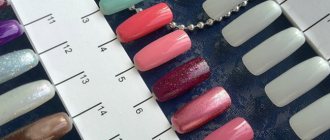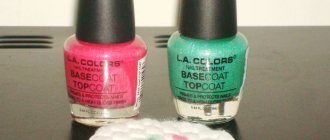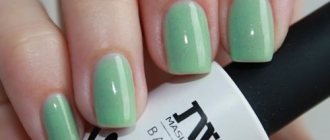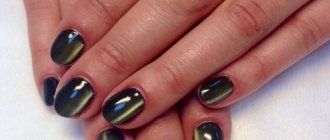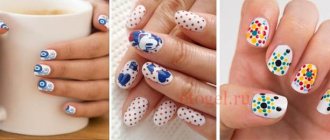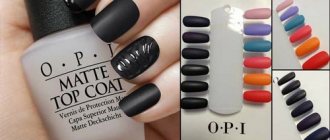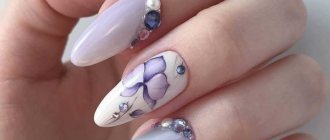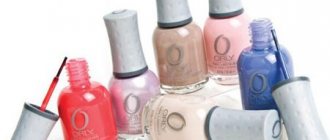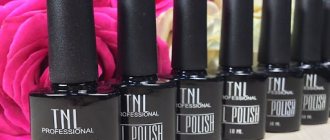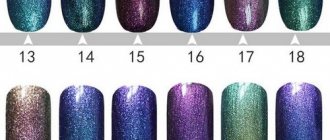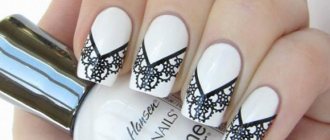What is a color wheel?
Color circle
is a palette of colors in the form of a circle, arranged in such a way that, using special rules, one can determine ideal combinations and see incompatible colors. We will analyze how to do this and all the rules of combination further.
The color wheel in manicure is used to select colors when performing nail design: it allows you to select from one to four colors that perfectly match each other. However, besides this, using the color wheel you can easily learn how to mix colors. This is very convenient if the range of paints or, for example, gel polishes at home is limited.
You can find different types of color wheel depending on the number of rings, but they all start with a basic circle.
The basic circle consists of 12 colors, which are formed as follows:
- Primary or primary colors
are three colors: red, yellow and blue. They form the “framework” of the color wheel because they cannot be created by mixing other colors. - Secondary colors
- green, purple and orange - are colors that are obtained by mixing two primary colors: blue + yellow = green, red + blue = purple, yellow + red = orange. - Tertiary or intermediate colors
are made by mixing one of the primary colors with one of the secondary colors. The resulting colors are called this way: the primary color comes first, and the secondary color is written after a hyphen, although many of them have their own separate names. There are only 6 tertiary colors: yellow-green (lime), yellow-orange (gold), red-violet (magenta), red-orange (scarlet), blue-green (turquoise), blue-violet (ink).
The expanded color wheel has several rings in its composition and is divided into sectors, each of which represents shades of the main color of its sector.
Mix varnishes in one bottle
Hello! My name is Natalya. I love working with flowers. And since mixing paints is yoga for the eyes and trampoline for fatia, I learned to mix varnishes in one bottle. If you are prudent, the result will be quite predictable. Well, if not, so much the more interesting!
I have long wanted to get a chameleon polish based on the Peridot principle, but there is nothing similar in the city. Sighing, I bought Turkish green Classics Metallic 08 and, doubting that it was capable of a rich shimmer of color, took gold Classics Metallic 03 to go with it.
Classic No. 8 has a pleasant chrysolite color. By the way, peridot and chrysolite are the same stone, it looks like this:
I learned about Classics Metallic 08 polish from a post by a Vogue co-conspirator, for which I thank her very much. The polish in her photo is flawless. Apparently, on smooth convex nails he is capable of nobility. Here's her post:
But he treated me like a swine and acted like a terrible, vulgar foil. I even regretted applying topcoat to it, thinking that nothing could save the disgrace. I tried how its brother, golden No. 3, looks in the same 2 layers. And I was not mistaken, they are a match.
Luckily, I know how to give cheap glitter a little shine. I always use Colorama Maybelline No. 256, light pink from the Glossy range. In fact, it is almost colorless with a small amount of mother-of-pearl. It comes in two variations - paler and pinker, I take the paler one.
I add it to the varnish, which suits me with the color, but not with the consistency and finish. Gives 1) a slight “dustiness” to the color, 2) slightly thickens liquid varnishes (and Classics are liquid, flowing), 3) gives a glossy finish, 4) does not add visible pearlescent, but adds depth to matte varnishes.
In the foreground of the photo is my “grown” hybrid. It contains almost a third of each polish, a little more from the green Classics than from the gold. But first, a little about the properties of the original Classics Metallic varnishes, and later about the resulting hybrid. Properties.
Classics Metallic varnishes are liquid and flow onto the skin even if the brush has not touched it.
The color (not the texture and shine, but the color) is good: No. 8 shimmers from gray-green through peridot to a soft gold, and No. 3 wanders between bright orangish gold and blue-green. The shimmer in them looks tiny, but the finish on the nail is dull and not mirror-like. 1 layer dries in about 8 minutes. Of course it will. The second one can cause baldness, you need to be careful. The second layer dries in about 12 minutes. The price of
varnishes is 65 rubles.
are rated
3.
Now about the hybrid. It was not possible to photograph him either in his embarrassed gray-green form or in his bright golden form. I tried to take pictures in the brightest place in the apartment. But believe me, it has these shades. The main colors of the “chameleon” are golden-green and bluish-green. Properties.
Compared to Classics Metallic, the hybrid is thicker, the color has become a little richer, and the finish has become glossier.
In my opinion, it doesn’t look like an expensive varnish, but still better than the originals. I’m testing the durability at the moment: I’ve been wearing it for four days, and the tips on my nails have worn off from knitting, but no more than half a millimeter. I am pleased. Price.
Cost me 65 rubles + 65 rubles + the cost of the Colorama 70 rubles.
Total 200 rub. Subjective assessment
of the brainchild 4+. Not a five because I want a richer color.
While I was waiting for registration, I found out that user Mirma also likes to mix polishes:
Increase
How to Combine Colors Using the Color Wheel
We have become a little familiar with the theory of the color wheel, now let’s look at the rules for combining colors. These rules are based on patterns that allow you to find ideal combinations of two, three or four colors. Let's look at them, starting with the simplest ones - combinations of two colors. If it is difficult for someone to navigate the description, I tried to clearly depict all the diagrams in the drawings.
1 – combinations of two colors
Monochrome scheme
– colors are selected from one sector of the color wheel. For example, if you take blue as the main color, then you can add lighter blue and sky colors to it.
Similar scheme
– a combination of colors from neighboring sectors, that is, adjacent to each other. This scheme is also called similar.
Linear diagram
– here colors that are opposite to each other are selected. That is, if you connect the colors of a circle with a straight line, they form a linear pattern. Its second name is additional or complementary. The linear scheme has variations: for example, you can choose one primary color, and the second will be shifted one sector from the opposite one in the circle (see figure). Other options for a linear scheme will be considered in combinations for three and four colors.
2 – combinations of three colors
Monochrome and linear schemes are also acceptable here, only 3 colors are used.
Triangular pattern
- This is the basic version of a combination of three colors, however, there are options here too. The main ones are combinations when colors are connected by equal segments, that is, an equilateral triangle is obtained. In this case, all colors lie within one ring of the circle. However, options are possible when one or two vertices of the triangle move within the sector, then the triangle will no longer be equilateral (see figure). The triangular scheme also has a second name – triadic.
– all colors are selected within one color ring: two additional colors to the main selected color will be the colors from the right and left adjacent sectors to the opposite color.
3 – combinations of four colors
Square diagram or tetraider
– the scheme is determined according to a similar principle to the triangular one: colors are selected that are located at the four vertices of the square. A rectangle option is also possible.
Double-linear
(or double-complementary) scheme - two colors are taken opposite to each other from a linear scheme, and the second two are also opposite, but from adjacent sectors. A deviation of one sector is possible, as for a linear diagram.
Additional Line Diagram
(or alternative complementary) - the three complementary to the main color will be the opposite and its two neighboring colors.
Instructions for applying pearlescent tones
Light gel polishes with mother-of-pearl have another problem: the particles of mother-of-pearl are not so small that they are not visible. Their enchanting iridescent glow is accompanied by the pattern of marks that remain from the brush. The smallest particles line up in lines. They are visible in certain lighting. It is very unsightly when these lines intersect or create zigzags. The coating is done in two stages.
- The angle of the brush is 45%; use the brush to place a drop near the cuticle. Carefully reaches towards the free edge.
- Using a brush, paint the left side of the nail with a confident movement, with the cap pointing to the right.
- With a confident brush, paint the right side of the nail, with the cap directed to the left.
- The end is sealed and the hand is placed in the lamp.
The second stage completely repeats the first.
Concepts of brightness and color saturation
Using the color schemes above, we can find good color combinations for manicures. However, the result may not be what you expect, since you also need to take into account brightness and saturation when choosing colors for your nail design.
The brightness of a color is determined by its saturation with dark or light tones. The further a color is from the center of the color wheel, the brighter it is, and vice versa, the closer the color is to the center, the more saturated with light tones it is, that is, less bright.
The grouping of colors is called color composition. It can be nuanced and contrasting depending on the brightness and saturation of colors.
- There will be a nuanced composition if you take as its basis neighboring colors that have the same saturation - they do not have a dominant color.
- A contrasting composition, on the contrary, is built on the basis of contrasting colors that are opposite in a circle. For example, black and white colors will be very contrasting to each other.
By the way, have you noticed that there is no black, white or their shades in the color wheel?
Base and dyes
As a base, you should use transparent varnishes that do not contain major harmful substances. I took the base foundation labeled "big3free". This means that it does not contain toluene, as well as formaldehyde and dibutyl phthalate. You can also choose safer types of varnish, for example “big4free” (without formaldehyde resins) or “big5free” (without camphor). These are the means that are considered the most harmless.
If your nails flake or break easily, then use a base with a minimum amount of aggressive substances. A healing transparent foundation with nourishing ingredients will also suit you.
To add color to the varnish, you can use any type of oil-based dye. But be sure to make sure that this pigment is intended for cosmetic use. Food coloring and craft glitter are not suitable for making DIY polish.
My favorite cosmetic dyes are mineral micas. These are powdery pigments that create a shimmering color and shimmer in all shades of the rainbow.
If you want to create a bright, glossy color, then choose low-soluble dyes, such as oxides or ultramarine. If you want to make a matte varnish, then add a pinch of corn starch to the composition.
About black and white flowers
Black and white colors are not on the color wheel because they are achromatic colors, meaning they are not colored. This also includes sulfur colors and their shades. The beauty of black and white colors is that they harmoniously combine with any of the colors on the color wheel, and you should pay attention to the contrast of the chosen colors, this has already been mentioned above. Black and white, as well as their shades, can be added to any of the previously listed schemes, thus obtaining up to 5 color combinations.
Lighting nuances
When choosing colors for a manicure, you should also remember the effect of lighting on color.
- Outdoor daylight gives your nail polish a warmer hue,
- When illuminated by a lamp indoors, the varnish will look, on the contrary, colder,
- In summer, it is customary to use brighter colors, since daylight hours are longer and natural light predominates; in winter, the opposite is true.
Consider the texture of the varnish or coating
The texture of the varnish can also affect the perception of color. For example, translucent pearlescent varnishes in the sun and in the shade are completely different colors. And if you apply pearlescent varnish over a colored one, it will also change its shade. Thus, it can be used to create new color combinations.
The same works for other textures. A matte surface will dull the color. The sand texture of the varnish works on the same principle.
Making a new varnish
Follow the instructions on how to make nail polish at home. It’s worth starting by choosing two varnishes that match each other. Then you should pour them into one jar.
Many people use one secret on how to make varnish thinner or thicker. You can also put one polish on top of another. While you go about your business, the varnish will mix naturally. After completing the procedure, mix and shake the bottle vigorously. With simple steps you will prepare a completely new varnish.
By gradually darkening you will get an attractive ombre effect. This effect is quite popular today. The positive thing is that such a varnish can be made independently.
Mixing colors using the color wheel
The second thing the color wheel is used for is mixing colors to get the desired shade.
. Mixing varnishes will be problematic - they dry quickly, but paints, gel paints or colored gels mix easily, which allows you to get a large palette and make the desired design.
I have already talked about how secondary and tertiary colors are obtained by mixing. You can always make a color darker or lighter by adding white and black in different proportions. This way you can get colors from one sector of the color wheel.
It is worth remembering that opposite colors on the color wheel can be used in a design, but not mixed together, as this will result in a muddy color that does not look good on the nails.
Is it possible to mix shellac of different colors?
Many people are accustomed to calling any gel polish shellac, but Shellac is only one of the companies producing this product. The confusion of names is comparable to how all copying machines in Russian-speaking countries are usually called “copiers,” although this was originally the name of the company that was one of the first to introduce devices that create copies.
Shellac CND gel polishes, the color mixing of which will be described below, are one of the most popular among craftsmen in the CIS countries.
Mixing shellacs (gel polishes) of different colors is an art that has its own secrets and features. There are masters who combine products of several shades in certain proportions in whole jars, but it is better to do this at a time.
Having just a few tubes of varnish in the main primary tones, you can create a spectacular manicure without large financial expenses, combining coatings of different shades with each other. The cosmetology industry offers special palettes for combining gel polishes.
Arguments in favor of application
Biogel is originally intended to strengthen natural nails. The color range of biogels is not as extensive as that of gels that are used for nail extensions. That is why many masters not only cover nails strengthened with biogel with shellac, but also recommend performing these two procedures together. Firstly, natural nails are under double protection. Biogel strengthens them and protects them from breakage. Shellac gives the manicure individuality and completeness, additionally strengthening it against breaks and chips. Secondly, Shellac applied to nails coated with biogel lasts even longer. There are cases where girls did not change their coverage for 1.5-2 months. At the same time, the appearance of the manicure remained impeccable.
What is gel polish correction?
Gel polish is a hybrid form of nail polish and gel. Unlike a regular varnish coating, gel polish does not wear off from the nails due to external influences (for example, washing dishes or cleaning the apartment), has a dense, uniform coating and stays on the nail plates for a very long time (up to 4 weeks). It is dried in a UV lamp.
Manicure correction using gel polish means a procedure for completely or partially updating the decorative coating of the nail plate, as well as performing work to remove hangnails, overgrown cuticles and forming the optimal length and shape of the free edge of the nail.
The frequency of correction depends on the speed of nail growth; it is completely different for everyone.
Mint design
Mint design To complete this design you will need only two varnishes - white and turquoise.
This is quite enough, despite the fact that the photo does not even show a two-color manicure. In addition to varnishes, you will also need a palette in which you will need to mix colors. First, the nails are covered with a manicure base. When it dries, the varnishes are mixed in the palette so that a very light mint shade is obtained. This is what is applied to one or two fingers. Then add a little more turquoise varnish to the shade in the palette to make the tone darker. Using a regular brush, paint the nails in the resulting color.
Next in the palette they make the shade even brighter. You need to work quickly so that the material does not have time to thicken and dry out. The resulting color is applied to the selected fingers. The finished and dried design is covered with a fixative or transparent varnish to secure it.
This is just one way to paint your nails with two colors at once. There are many other technologies that are available at home. In this case, no special tools are required.
Is it possible to mix gel with acrylic paints?
Another way to add zest to your manicure is to mix gel and acrylic paint. True, there is no exact formula, so you can achieve a high-quality result only through experimentation.
The fact is that all gels react differently to interaction with acrylic; they can curl up to the consistency of plasticine, which in this form is not at all suitable for work.
In order not to spoil the material, try mixing a drop of gel with eye shadow or powder and see what the result is.
Mixing these two components affects the structure of the material into which the foreign object has fallen, but most often the experiments still end successfully.
If you are concerned about the question of whether it is possible to mix gel with acrylic powder , then you can safely do so.
Craftsmen successfully combine these two materials, making a colored base using gel polish, then applying acrylic powder and design elements.
Can the gel be mixed with regular nail polish?
The unique gel material can be mixed not only with acrylic, but also with conventional varnishes.
This will come in handy when creating an unusual design and in cases where you don’t have the right color gel on hand. True, there are some subtleties here too.
